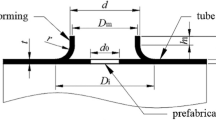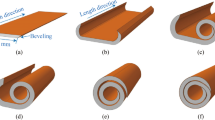Abstract
The forming limitation and the wall thickness distributions are the two main parameters for estimating the forming quality of T-shaped tubes. In this paper, the effects of three key factors on the forming limitation and the wall thickness distributions are investigated, which are punch front distance l1, reverse height h1, and the matching relationship between rubber hardness and axial feed Δl. A new position-limited backpressure mechanism is proposed, which is made up of the rigid position-limited lever, the flexible backpressure medium, and the rigid spacer. The simulations and experiments are carried out. Both results show that the thinning rate of the wall thickness decreases first and then increases, and the thickening rate decreases gradually with the increase of l1. The branch reaches the highest with the l1 of 5mm under the requirements of thinning rate and thickening rate. With the rise of reverse height h1, the bigger h1 is beneficial to the wall thickness thinning suppress at the top of the branch, and the branch reached the highest when h1 is 7mm. When Δl is fixed, the rubber hardness has a significant influence on the forming defects. The exorbitant rubber hardness causes the branch to rupture, and the excessive axial feed causes the wall to wrinkle. When rubber hardness is fixed, the thickening rate decreases with the increase of Δl. The best forming limitation and thickness distribution are achieved with the punch front distance l1 of 5mm, the reverse height h1 of 7mm, the rubber hardness of 75HA, and the axial feed Δl of 24mm.





















Similar content being viewed by others
Data availability
Not applicable
Code availability
Not applicable
References
Vakili-Tahami F, Majnoun P, Ziaei-Asl A (2019) Controlling the in-service welding parameters for T-shape steel pipes using neural network. Int J Press Vessel Pip 175:103937
Dong GJ, Bi J, Du B, Chen XH, Zhao CC (2017) Research on AA6061 tubular components prepared by combined technology of heat treatment and internal high pressure forming. J Mater Process Technol 242:126–138
Lang LH, Yuan SJ, Wang ZR, Wang XS, Danckert J, Nielsen KB (2004) Experimental and numerical investigation into useful wrinkling during aluminium alloy internal high-pressure forming. Proc Inst Mech Eng B J Eng Manuf 218(1):43–49
Yuan SJ, Liu G (2014) 3.04-Tube Hydroforming (Internal High-Pressure Forming). In: Comprehensive Materials Processing, Hashmi S, Batalha GF, Van Tyne CJ, Yibas B, Eds. Oxford: Elsevier, pp 55–80
Trana K (2002) Finite element simulation of the tube hydroforming process-bending performing and hydroforming. J Mater Process Technol 127(3):401–408
Ray P, Mac Donald BJ (2005) Experimental study and finite element analysis of simple X- and T-branch tube hydroforming processes. Int J Mech Sci 47:1498–1518
Feng YY, Zhang HG, Luo ZA, Wu QL (2019) Loading path optimization of T tube in hydroforming process using response surface method. Int J Adv Manuf Technol 101:1979–1995
Liu J, Yao X, Li Y, Liang H, Yang L (2019) Investigation of the generation mechanism of the internal pressure of metal thin-walled tubes based on liquid impact forming. Int J Adv Manuf Technol 105:3427–3436
Dai LF (2018) Study on the influence factors of Hydroforming of 5A02 aluminum alloy Reducer Tee. Nanchang Hangkong University
Ramezani M, Ripin ZM (2012) Tube bulging using rubber rods. In: Rubber-Pad Forming Processes: Technology and Applicantions, Woohead Publishing, pp 229–256
Nosrati HG, Gerdooei M, Naghibi MF (2016) Experimental and numerical study on formability in tube bulging: a comparison between hydroforming and rubber pad forming. Mater Manuf Process 32(12):1353–1359
Koubaa S, Belhassen L, Wali M, Dammak F (2017) Numerical investigation of the forming capability of bulge process by using rubber as a forming medium. Int J Adv Manuf Technol 92(5-8):1839–1848
Belhassen L, Koubaa S, Wail M, Dammak F (2019) Experimental and numerical investigation of flexible bulging process of aluminum aa1050-h14 sheet metal with soft tools. Int J Adv Manuf Technol 103(9-12):4837–4846
Gao HF, Zhao W, Sun AX, Wang M (2003) Study on compound forming of bulging and extrusion of tri-branch tube. Hot Working Technology (6):19–20+64
Wang HF (2004) Forming study and process control of the multi-tube’s hydroforming. Northwestern Polytechnical University
Chen ZZ, Liu B (2011) Simulation of bulge forming process for three-way tube using rubber medium. J Huaqiao Univ (Natural Science) 32:485–491
Chen ZZ, Liu B (2011) Simulation of Compound bulging process for T-branch tubes using rubber medium. Adv Mater Res 228-229:88–95
Zou QS, Liu B (2013) Influence of mold structure parameters on T-shapes tubes by compound bulging using rubber medium. J Huaqiao Univ (Natural Science) 34:121–125
Chen ZZ (2011) Research on compound bulging technology of T-branch tube based on elastic medium. Huaqiao University
Wang Y, Nielsen KB, Lang L, Endelt B (2018) Investigation into bulging-pressing compound forming for sheet metal parts with very small radii [J]. Int J Adv Manuf Technol 95:445–457
Kim B, Lee SB, Lee J, Cho S, Park H, Park YSH (2012) A comparison among Neo-Hookean model, Mooney-Rivlin model, and Ogden model for chloroprene rubber [J]. Int J Precis Eng Manuf 13(5):759–764
Zhang L, Li ZH, Ma XQ (2018) Study on parameter characteristics of rubber Mooney-Rivlin model. Noise Vib Control 38:427–430
Liu G, Xie WC, Yuan SJ, Yao JQ, Miao QB (2004) Internal high pressure forming of hollow part with a big section difference. J Mater Sci Technol 12(4):398–401
Zhu SJ, Li J, Lin XK, Chang X, Su HD, Wu L (2018) Simulation and optimization on hydroforming of T-shape tube based on orthogonal experiment. Forging & Stamping Technology 43(9):75–82
Li XM, Xia JQ, Hu GA (2002) Technology analysis and forming force calculation of compound forming of solid three-way tube. China Metalforming Equipment & Manufacturing Technology 4:37–38
Yang ZZ, Wang GF, Liu YL, Huang L, Nie XH, Xu Y, Zhao JL (2019) Correlation between processing technology and cross-sectional distortion of small-radius hot-bending. Oil & Gas Storage and Transportation 38(03):338–344
Xu XB, Guan Q (2010) Numerical simulation of wall thickness change in tube bending. Forging & Stamping Technology 35(06):133–136
Peng JY, Luo DG, Teng BG, Liu G (2017) Analysis on wrinkling and cracking initiation in hydroforming thin-walled Y-shaped tubes. Mater Sci Technol 25(04):11–16
Zhai JB, Yu XH, Zhai NZ (2007) Comparison of T-tube compound bulging and axial-compressive bulging processes. China Metalforming Equipment & Manufacturing Technology 2:82–86
Acknowledgements
The authors wish to express their gratitude.
Funding
This work was financially supported by the Natural Science Foundation of Liaoning Province, China (No. 2019ZD0240).
Author information
Authors and Affiliations
Contributions
The first author (corresponding author) is the supervisor teacher and helped design the experiments and provided the experiment setups. The second author organized the data and wrote the paper. The fourth author provided financial supports and suggestions in experiments. The third and fifth authors helped with the experiments.
Corresponding author
Ethics declarations
Ethics approval
The work was original research that has not been published previously, and not under consideration for publication elsewhere, in whole or in part.
Consent to participate
The authors all approved to participate.
Consent for publication
It is approved by all authors for publication
Conflict of interest
The authors declare no competing interests.
Additional declarations for articles in life science journals that report the results of studies involving humans and/or animals
Not applicable
Additional information
Publisher’s note
Springer Nature remains neutral with regard to jurisdictional claims in published maps and institutional affiliations.
Rights and permissions
About this article
Cite this article
Han, Z., Wei, C., Du, S. et al. Numerical simulation and experimental research on rubber flexible-die forming limitation with new position-limited backpressure mechanism. Int J Adv Manuf Technol 116, 2183–2196 (2021). https://doi.org/10.1007/s00170-021-07583-5
Received:
Accepted:
Published:
Issue Date:
DOI: https://doi.org/10.1007/s00170-021-07583-5




